Ring finger facts for kids
Quick facts for kids Ring finger |
|
|---|---|
 |
|
| A human left-hand with the ring finger extended | |
| Latin | Digitus IV manus, digitus quartus manus, digitus annularis manus, digitus medicinalis |
| Artery | Proper palmar digital arteries, dorsal digital arteries |
| Vein | Palmar digital veins, dorsal digital veins |
| Nerve | Dorsal digital nerves of radial nerve, Dorsal digital nerves of ulnar nerve, Proper palmar digital nerves of median nerve |
The ring finger is the fourth finger on your hand. It sits between your middle finger and your little finger. People also call it the third finger or fourth finger.
This finger is most famous for its connection to wedding rings. Many cultures around the world wear wedding rings on this finger. While traditionally only brides wore a wedding ring, now many men wear them too. Sometimes, an engagement ring is also worn on the ring finger before marriage.
In the world of anatomy, which is the study of the body, the ring finger has a few scientific names. These include digitus medicinalis, the fourth digit, digitus annularis, or digitus quartus. In Latin, the word anulus means "ring", digitus means "digit" (or finger), and quartus means "fourth".
Contents
Why Is It Called the Ring Finger?
The exact reason why the fourth finger was chosen for rings isn't fully known. Some old beliefs suggest it might be a special or "magical" finger. In many languages, its name means something about magic or rings. Sometimes, it's even called the "nameless" finger.
Names Around the World
In Japanese, the ring finger is called 薬指 (kusuri yubi). This means "medicine finger." People used it to take traditional powdered medicine. They thought it was the cleanest finger because it wasn't used much for other tasks.
Other languages also have interesting names for this finger. In Sanskrit, Finnish, and Russian, it's called "Anamika," "nimetön," and "Безымянный" respectively. All these names mean "nameless."
In Arabic, the ring finger is called bansur, which means "victory." In Hebrew, it's kmitsa, meaning "taking a handful."
The History of the Ring Finger
For a long time, people believed a special vein connected the fourth finger of the left hand directly to the heart. Before medical science understood how our circulatory system works, this idea was very popular.
This special vein was called the vena amoris, which is Latin for "vein of love." Because of this believed connection between the hand and the heart, people thought it was the perfect place to wear a wedding ring. Wearing the ring on this finger was a way for married couples to show their never-ending love.
In Britain, only women usually wore wedding rings until after the World Wars. After these wars, many married male soldiers started wearing rings. It helped them remember their partners while they were away.
Ring Finger Customs Today
Western Traditions
In Western cultures, people usually wear a wedding ring on the fourth finger. This tradition started with the Romans. A man would give a ring to a woman during their engagement ceremony. Placing the ring on the bride's finger during the wedding became common around the 11th century.
In medieval Europe, during Christian wedding ceremonies, the ring was placed on different fingers of the left hand: first the thumb, then the index, then the middle, and finally the ring finger. It was then left on the ring finger.
In some European countries, people wear the ring on their left hand before marriage. Then, they move it to their right hand during the wedding ceremony. For example, in the Eastern Orthodox Church, a bride wears the ring on her left hand before the wedding. After the wedding, she moves it to her right hand.
Most people in countries that were once part of the British Empire, like Australia, Canada, and the UK, wear the wedding ring on the left ring finger. This is also common in France, Italy, and Sweden. However, in Spain, the ring is usually worn on the right hand.
Some countries, especially in Eastern Europe like Russia and Ukraine, wear the wedding ring on the right ring finger. This is also true for Germany, Greece, and Norway. In some places like Turkey and Brazil, the ring is worn on the right hand until the wedding day, then moved to the left.
Other Cultural Traditions
In Sinhalese and Tamil cultures, the groom wears his wedding ring on his right hand. However, the bride wears hers on her left hand.
Wedding rings are not a traditional part of Islamic weddings in most Islamic countries. If a ring is worn, it might be on the left hand, as in Iran. In Jordan, people wear engagement rings on the right ring finger and wedding rings on the left. Rings for engagement are quite common in Muslim countries, and they can be worn on either the right or left hand by both men and women.
In a traditional Jewish wedding ceremony, the wedding ring is placed on the bride's right-hand index finger. Sometimes, it's placed on the middle finger or thumb. Today, the ring is usually moved to the left hand ring finger after the ceremony. While some Jewish grooms wear a wedding ring, most men in Orthodox Judaism do not.
Rings are not a traditional part of an Indian wedding. However, it's becoming more common for people to wear rings for engagements. Even though the left hand is sometimes seen as less lucky for religious activities, a ring (not called a wedding ring) is still often worn on the left hand. Men usually wear rings on their right hand, and women on their left.
Images for kids
See also
 In Spanish: Dedo anular para niños
In Spanish: Dedo anular para niños



